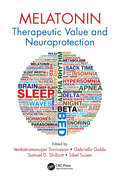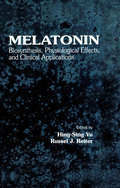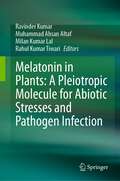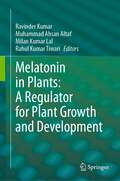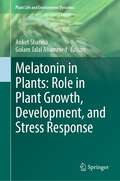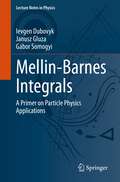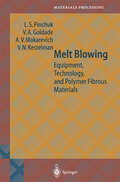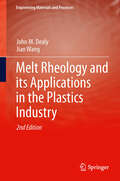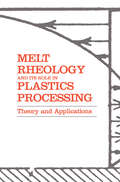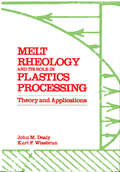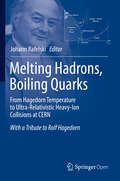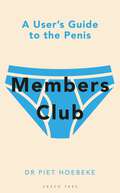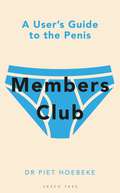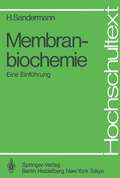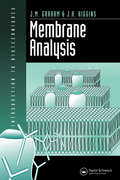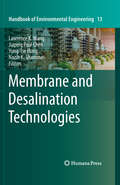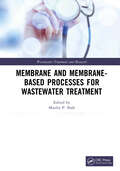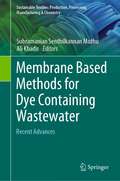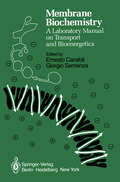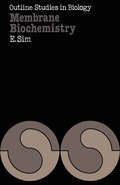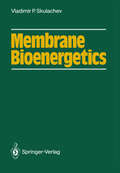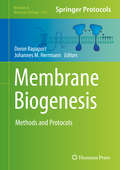- Table View
- List View
Melatonin: Therapeutic Value and Neuroprotection
by Venkatramanujan Srinivasan Gabriella Gobbi Samuel D. Shillcutt Sibel SuzenThere is growing interest in the field of melatonin research regarding its neurobiological mechanisms as well as its repercussions in clinical practice. Melatonin: Therapeutic Value and Neuroprotection explores melatonin's neuroprotective effects and discusses the therapeutic potential of melatonin and melatonin agonists in treating neurodegenerati
Melatonin: Biosynthesis, Physiological Effects, and Clinical Applications
by Hing-Sing Yu Russel J. ReiterMelatonin: Biosynthesis, Physiological Effects, and Clinical Applications provides a thorough review of recent advances in major areas of melatonin research. The book is arranged in a logical sequence, beginning with the history of melatonin and then proceeding to cover its biochemistry and secretion, physiological effects, and clinical significance. New findings and current concepts are emphasized, and a significant amount of previously unpublished data are included. The book will be an important reference for neurobiologists, cell biologists, ophthalmologists, endocrinologists, neuroendocrinologists, reproductive biologists, psychiatrists, and other researchers and clinicians interested in melatonin.
Melatonin: Biosynthesis, Physiological Effects, and Clinical Applications
by Hing-Sing Yu Russel J. ReiterMelatonin: Biosynthesis, Physiological Effects, and Clinical Applications provides a thorough review of recent advances in major areas of melatonin research. The book is arranged in a logical sequence, beginning with the history of melatonin and then proceeding to cover its biochemistry and secretion, physiological effects, and clinical significance. New findings and current concepts are emphasized, and a significant amount of previously unpublished data are included. The book will be an important reference for neurobiologists, cell biologists, ophthalmologists, endocrinologists, neuroendocrinologists, reproductive biologists, psychiatrists, and other researchers and clinicians interested in melatonin.
Melatonin in Plants: A Pleiotropic Molecule for Abiotic Stresses and Pathogen Infection
by Ravinder Kumar Muhammad Ahsan Altaf Milan Kumar Lal Rahul Kumar TiwariThis edited book highlights the multifunctional role of the ubiquitous molecule, melatonin in crop plants. The major focus of this edition is to provide a comprehensive insight into the key focus is on Melatonin mediated alleviation of abiotic stresses and pathogens infection. The inception of melatonin as an animal hormone and the subsequent discovery of its multifaceted function in the animal system has revolutionized the research on this penial hormone. During the last decade, the discovery, quantification and functional studies of melatonin as phytohormone has emerged at a rapid pace. Recently, this phyto-protectant has become an integral component of lab and field-based research on the mitigation of adverse effects of climate-driven abiotic stresses and postharvest biology and technology.The book explores melatonin mediated management of various abiotic stresses such as drought, salinity, heat and cold temperature. The book also focuses on role of melatonin in heavy metal stress, viral, bacterial, and fungal diseases, and, also contains chapter on melatonin facilitated nutrient use efficiency in plants. This book is of interest to postharvest industries, horticulturists, scientists, researchers, and students.
Melatonin in Plants: A Regulator for Plant Growth and Development
by Ravinder Kumar Muhammad Ahsan Altaf Milan Kumar Lal Rahul Kumar TiwariThis book highlights the multifunctional role of the ubiquitous molecule, melatonin, in crop plants. The major focus of this edition is to provide detailed insights into morphophysiological, biochemical, and molecular responses of melatonin in the growth and development of the plant. The inception of melatonin as an animal hormone and the subsequent discovery of its multifaceted function in the animal system has triggered the research on this pineal gland hormone. During the last decade, the discovery, quantification and functional studies of melatonin as phytohormone has emerged at a rapid pace. Recently, this phyto-protectant has become an integral component of lab and field-based research on the mitigation of adverse effects of climate-driven abiotic stresses and postharvest biology and technology.The book explores various biosynthetic pathways and detection of melatonin covering its role in flowering, fruit development, photosynthesis, respiration, hormonal crosstalk, post-harvest biology and reactive oxygen species and nitrogen cycles. This book is of high interest to postharvest industries, horticulturists, scientists, researchers, and students.
Melatonin in Plants: Role in Plant Growth, Development, and Stress Response (Plant Life and Environment Dynamics)
by Anket Sharma Golam Jalal AhammedThis edited book compiles multifaceted functions of melatonin in plant growth, development, and stress response. The main focus of the book is to address the recent most developments in the arena of melatonin-mediated regulation of stress tolerance. Plants are continuously challenged by both biotic and abiotic stressors, which have negative impacts on growth and development. Stimulation of exogenous cues and endogenous signals can help plants to better withstand biotic and abiotic stresses. Melatonin is an important biologically active compound that acts as a multifunctional signaling molecule and regulates key physiological and biochemical processes. Currently, researchers all over the globe have been exploring the in-depth mechanisms of melatonin-modulated regulation of plant biology using various advanced molecular techniques. These recent advancements in melatonin research have possible applications in plant stress management as well as developing stress-tolerant crop varieties. This book is of interest to university teachers, researchers, plant scientists, industry professionals, and policymakers on a global scale.It also serves as a reading material for undergraduate and graduate students of agriculture, forestry, plant biology, and environmental sciences.
Mellin-Barnes Integrals: A Primer on Particle Physics Applications (Lecture Notes in Physics #1008)
by Ievgen Dubovyk Janusz Gluza Gábor SomogyiIn this book, the authors discuss the Mellin-Barnes representation of complex multidimensional integrals. Experiments frontiered by the High-Luminosity Large Hadron Collider at CERN and future collider projects demand the development of computational methods to achieve the theoretical precision required by experimental setups. In this regard, performing higher-order calculations in perturbative quantum field theory is of paramount importance. The Mellin-Barnes integrals technique has been successfully applied to the analytic and numerical analysis of integrals connected with virtual and real higher-order perturbative corrections to particle scattering. Easy-to-follow examples with the supplemental online material introduce the reader to the construction and the analytic, approximate, and numeric solution of Mellin-Barnes integrals in Euclidean and Minkowskian kinematic regimes. It also includes an overview of the state-of-the-art software packages for manipulating and evaluating Mellin-Barnes integrals. The book is meant for advanced students and young researchers to master the theoretical background needed to perform perturbative quantum field theory calculations.
Melt Blowing: Equipment, Technology, and Polymer Fibrous Materials (Springer Series in Materials Processing)
by L.S. Pinchuk Vi.A. Goldade A.V. Makarevich V.N. KestelmanThis book is devoted to a nontraditional class of materials which are manufactured by the melt-blowing process. The text examines the structure and main properties of melt-blown materials as conditioned by peculiarities of overheated polymer melt spraying in oxidizing medium. Information is given about filtering mechanisms and the main types of polymer fibrous filtering materials.
Melt Rheology and its Applications in the Plastics Industry (Engineering Materials and Processes)
by John M Dealy Jian WangThis is the second edition of Melt Rheology and its Role in Plastics Processing, although the title has changed to reflect its broadened scope. Advances in the recent years in rheometer technology and polymer science have greatly enhanced the usefulness of rheology in the plastics industry. It is now possible to design polymers having specific molecular structures and to predict the flow properties of melts having those structures. In addition, rheological properties now provide more precise information about molecular structure.This book provides all the information that is needed for the intelligent application of rheology in the development of new polymers, the determination of molecular structure and the correlation of processability with laboratory test data. Theory and equations are limited to what is essential for the use of rheology in the characterization of polymers, the development of new plastics materials and the prediction of plastics processing behavior. The emphasis is on information that will be of direct use to practitioners. Extensive references are provided for those wishing to pursue certain issues in greater depth. While the primary audience is applied polymer scientists and plastics engineers, the book will also be of use to postgraduate students in polymer science and engineering and as a text for a graduate course.
Melt Rheology and Its Role in Plastics Processing: Theory and Applications
by John M Dealy K.F. WissbrunThis book is designed to fulfill a dual role. On the one hand it provides a description of the rheological behavior of molten poly mers. On the other, it presents the role of rheology in melt processing operations. The account of rheology emphasises the underlying principles and presents results, but not detailed deriva tions of equations. The processing operations are described qualita tively, and wherever possible the role of rheology is discussed quantitatively. Little emphasis is given to non-rheological aspects of processes, for example, the design of machinery. The audience for which the book is intended is also dual in nature. It includes scientists and engineers whose work in the plastics industry requires some knowledge of aspects of rheology. Examples are the polymer synthetic chemist who is concerned with how a change in molecular weight will affect the melt viscosity and the extrusion engineer who needs to know the effects of a change in molecular weight distribution that might result from thermal degra dation. The audience also includes post-graduate students in polymer science and engineering who wish to acquire a more extensive background in rheology and perhaps become specialists in this area. Especially for the latter audience, references are given to more detailed accounts of specialized topics, such as constitutive relations and process simulations. Thus, the book could serve as a textbook for a graduate level course in polymer rheology, and it has been used for this purpose.
Melt Rheology and Its Role in Plastics Processing: Theory and Applications
by K. WissbrunThis book is designed to fulfill a dual role. On the one hand it provides a description of the rheological behavior of molten poly mers. On the other, it presents the role of rheology in melt processing operations. The account of rheology emphasises the underlying principles and presents results, but not detailed deriva tions of equations. The processing operations are described qualita tively, and wherever possible the role of rheology is discussed quantitatively. Little emphasis is given to non-rheological aspects of processes, for example, the design of machinery. The audience for which the book is intended is also dual in It includes scientists and engineers whose work in the nature. plastics industry requires some knowledge of aspects of rheology. Examples are the polymer synthetic chemist who is concerned with how a change in molecular weight will affect the melt viscosity and the extrusion engineer who needs to know the effects of a change in molecular weight distribution that might result from thermal degra dation. The audience also includes post-graduate students in polymer science and engineering who wish to acquire a more extensive background in rheology and perhaps become specialists in this area. Especially for the latter audience, references are given to more detailed accounts of specialized topics, such as constitutive relations and process simulations. Thus, the book could serve as a textbook for a graduate level course in polymer rheology, and it has been used for this purpose.
Melting Hadrons, Boiling Quarks - From Hagedorn Temperature to Ultra-Relativistic Heavy-Ion Collisions at CERN: With a Tribute to Rolf Hagedorn
by Johann RafelskiThis book shows how the study of multi-hadron production phenomena in the years after the founding of CERN culminated in Hagedorn's pioneering idea of limiting temperature, leading on to the discovery of the quark-gluon plasma -- announced, in February 2000 at CERN.Following the foreword by Herwig Schopper -- the Director General (1981-1988) of CERN at the key historical juncture -- the first part is a tribute to Rolf Hagedorn (1919-2003) and includes contributions by contemporary friends and colleagues, and those who were most touched by Hagedorn: Tamás Biró, Igor Dremin, Torleif Ericson, Marek Gaździcki, Mark Gorenstein, Hans Gutbrod, Maurice Jacob, István Montvay, Berndt Müller, Grazyna Odyniec, Emanuele Quercigh, Krzysztof Redlich, Helmut Satz, Luigi Sertorio, Ludwik Turko, and Gabriele Veneziano.The second and third parts retrace 20 years of developments that after discovery of the Hagedorn temperature in 1964 led to its recognition as the melting point of hadrons into boiling quarks, and to the rise of the experimental relativistic heavy ion collision program. These parts contain previously unpublished material authored by Hagedorn and Rafelski: conference retrospectives, research notes, workshop reports, in some instances abbreviated to avoid duplication of material, and rounded off with the editor's explanatory notes.About the editor: Johann Rafelski is a theoretical physicist working at The University of Arizona in Tucson, USA. Born in 1950 in Krakow, Poland, he received his Ph.D. with Walter Greiner in Frankfurt, Germany in 1973. Rafelski arrived at CERN in 1977, where in a joint effort with Hagedorn he contributed greatly to the establishment of the relativistic heavy ion collision, and quark-gluon plasma research fields. Moving on, with stops in Frankfurt and Cape Town, to Arizona, he invented and developed the strangeness quark flavor as the signature of quark-gluon plasma.
Members Club: A User's Guide to the Penis
by Piet HoebekeWherever there are people, there are penises. And even though men always carry their penis with them, we might not know it as well as we think...Members Club is a fascinating and important exploration of the penis written by leading urologist, Piet Hoebeke. 'Piet Hoebeke knows dick all, which in this case is the highest compliment.' – Tom RosenthalHalf of the world's population has one; the other half sometimes comes into contact with it, and yet a great deal of ignorance exists regarding the penis. Join celebrated professor of urology Piet Hoebeke, one of the world's leading experts in his field, as he sets out to clarify the mysteries of the male reproductive organ. Professor Hoebeke draws on his years of experience to address the key questions, such as: What is the ideal penis? What's the best technique for taking a pee? Why is an erection that lasts 24 hours a bad thing? And, of course: What to do when your foreskin gets stuck between the zipper of your trousers?Other areas covered include: the evolution of the penis, size, deviations, sexual health, the disturbed relationship between the man and his penis, sperm production, and the art of good penis maintenance.Members Club is the no-nonsense guide every penis user needs.
Members Club: A User's Guide to the Penis
by Piet HoebekeHalf of the world's population has one, the other half sometimes comes into contact with it, and yet a great deal of ignorance exists regarding the penis. Surprisingly many men think their penis is too short, even if it is above average in length. The fact that the morning erection is the last of eight nightly erections is a well-kept secret. Or that the foreskin, once unfolded, is as big as a postcard. Men always carry their penis with them, but they do not know it as well as they think. In this book, urologist Piet Hoebeke clarifies the mysteries of the male reproductive organ. Accessibly and humouristically written, Hoebeke explains the penis: Why do we have one? What does it do? How do I keep it fit and healthy? And of course: what to do when your foreskin gets stuck between the zipper of your pants?
Membrane Analysis
by Dr John Graham Joan HigginsMembrane Analysis provides a comprehensive review of laboratory methods for membrane study, with an emphasis on isolating membranes, analysing their composition and architecture, and investigating membrane function.
Membrane Analysis
by Dr John Graham Joan HigginsMembrane Analysis provides a comprehensive review of laboratory methods for membrane study, with an emphasis on isolating membranes, analysing their composition and architecture, and investigating membrane function.
Membrane and Desalination Technologies (Handbook of Environmental Engineering #13)
by Lawrence K. Wang, Jiaping Paul Chen, Yung-Tse Hung and Nazih K. ShammasIn this essential new volume, Volume 13: Membrane and Desalination Technologies, a panel of expert researchers provide a wealth of information on membrane and desalination technologies. An advanced chemical and environmental engineering textbook as well as a comprehensive reference book, this volume is of high value to advanced graduate and undergraduate students, researchers, scientists, and designers of water and wastewater treatment systems. This is an essential part of the Handbook of Environmental Engineering series, an incredible collection of methodologies that study the effects of pollution and waste in their three basic forms: gas, solid, and liquid. Chapters adopt the series format, employing methods of practical design and calculation illustrated by numerical examples, including pertinent cost data whenever possible, and exploring in great detail the fundamental principles of the field. Volume 13: Membrane and Desalination Technologies is an essential guide for researchers, highlighting the latest developments in principles of membrane technology, membrane systems planning and design, industrial and municipal waste treatments, desalination requirements, wastewater reclamation, biofiltration, and more.
Membrane and Membrane-Based Processes for Wastewater Treatment (Wastewater Treatment and Research)
by Maulin P. ShahThe proposed book mainly sorts out emerging and burning issues faced day to day by municipal and industrial wastewater treatments. It also provides a comprehensive view of recent advances in hybrid treatment technologies for wastewater treatment, addresses the current limitations and challenges of applying these tools in wastewater treatment systems. This book gives an insight about recent developments in membrane technology for wastewater treatment. Industrial wastewater contains a large variety of compounds, such as heavy metals, salts and nutrients, which makes its treatment challenging. Thus, the use of conventional water treatment methods is not always effective. In this sense, membrane-based hybrid processes have emerged as a promising technology to treat complex industrial wastewater. The present book analyses and discusses the potential of membrane-based hybrid processes for the treatment of complex industrial wastewater along with the recovery of valuable compounds and water reutilization. In addition, recent and future trends in membrane technology are highlighted. FEATURES 1. The properties, mechanisms, advantages, limitations and promising solutions of different types of membrane technologies are discussed. 2. The optimization of process parameters is addressed. 3. The performance of different membranes is described. 4. The potential of nanotechnology to improve the treatment efficiency of wastewater treatment plants is presented. 5. The application of membrane and membrane-based hybrid treatment technologies for wastewater treatment is covered.
Membrane and Membrane-Based Processes for Wastewater Treatment (Wastewater Treatment and Research)
by Maulin P. ShahThe proposed book mainly sorts out emerging and burning issues faced day to day by municipal and industrial wastewater treatments. It also provides a comprehensive view of recent advances in hybrid treatment technologies for wastewater treatment, addresses the current limitations and challenges of applying these tools in wastewater treatment systems. This book gives an insight about recent developments in membrane technology for wastewater treatment. Industrial wastewater contains a large variety of compounds, such as heavy metals, salts and nutrients, which makes its treatment challenging. Thus, the use of conventional water treatment methods is not always effective. In this sense, membrane-based hybrid processes have emerged as a promising technology to treat complex industrial wastewater. The present book analyses and discusses the potential of membrane-based hybrid processes for the treatment of complex industrial wastewater along with the recovery of valuable compounds and water reutilization. In addition, recent and future trends in membrane technology are highlighted. FEATURES 1. The properties, mechanisms, advantages, limitations and promising solutions of different types of membrane technologies are discussed. 2. The optimization of process parameters is addressed. 3. The performance of different membranes is described. 4. The potential of nanotechnology to improve the treatment efficiency of wastewater treatment plants is presented. 5. The application of membrane and membrane-based hybrid treatment technologies for wastewater treatment is covered.
Membrane Based Methods for Dye Containing Wastewater: Recent Advances (Sustainable Textiles: Production, Processing, Manufacturing & Chemistry)
by Subramanian Senthilkannan Muthu Ali KhadirThis book highlights recent findings of membrane - based dye removal methods along with the application of photocatalytic, nanofiltration and ultrafiltration membrane including membrane – based fibers, metal-organic frameworks, polyethersulfone, ceramic, etc. Among water and wastewater pollutants, dyes have been normally observed and detected in various aquatic solutions, including rivers and lakes. Aesthetic pollution, toxicity, persistent, and carcinogenicity are some of the adverse effects of dyes entering the ecosystem. Although dyes have brought a colourful world, their presence in the environment are responsible for adverse effects on the planet. Diverse physical, chemical and biological methods are available to treat dye contaminated water. This book presents membrane separation technology that has been developed in the past decade to treat different wastewaters, and owning to its effective performance, has garnered the attention of academia and industry alike.
Membrane Biochemistry: A Laboratory Manual on Transport and Bioenergetics
by E. Carafoli G. SemenzaThis manual collects in the form of laboratory protocols a series of experiments in the field of Membrane Transport and Membrane Bioenergetics. It represents the experience accumulated during four advanced courses held at the Depart ment of Biochemistry of the Swiss Federal Institute of Technology on behalf of Federation of European Biochemical Societies (FEBS) in the years 1975 through 1978. The idea of collecting the experiments into a laboratory manual developed as a response to a demand from the students who took part in the courses. Further motivation came with the fmding that, in planning the laboratory sessions, the teaching staff had no organized, modern source of information in the literature. The experiments presented cover most areas of importance in the subject mat ter. Their presentation has been continuously modified in the course of the four years during which the manual took shape, to accommodate to experience and various suggestions. In their present form, all of the experiments described have been repeatedly practiced to optimize their execution. Efforts have been made to combine in the manual classical experiments, and techniques which require relatively unsophisticated instrumentation and can therefore be carried out in most laboratories, with more modern experiments and relatively newer technol ogies. In its present form, the manual should therefore provide a usefui tool in the hands of researchers and laboratory teachers at different levels of sophisti cation and instrumentation.
Membrane Biochemistry
by Edith SimThe student of biological science in his final years as an undergraduate and his first years as a graduate is expected to gain some familiarity with current research at the frontiers of his discipline. New research work is published in a perplexing diversity of publications and is inevitably concerned with the minutiae of the subject. The sheer number of research journals and papers also causes confusion and difficulties of assimilation. Review articles usually presuppose a background knowledge of the field and are inevitably rather restricted in scope. There is thus a need for short but authoritative introductions to those areas of modern biological research which are either not dealt with in standard introductory textbooks or are not dealt with in sufficient detail to enable the student to go on from them to read scholarly reviews with profit. This series of books is designed to satisfy this need. The authors have been asked to produce a brief outline of their subject assuming that their readers will have read and remembered much of a standard introductory textbook of biology. This outline then sets out to provide by building on this basis, the conceptual framework within which modern research work is progressing and aims to give the reader an indication of the problems, both conceptual and practical, which must be overcome if progress is to be maintained.
Membrane Bioenergetics
by Vladimir P. SkulachevMembrane bioenergetics is one of the most rapidly growing areas within physico-chemical biology. Main aspects treated in this book include energy conservation and utilization by membrane-linked molecular mechanisms such as intracellular respiration, photosynthesis, transport phenomena, rotation of bacterial flagella, and the regulation of heat production.
Membrane Biogenesis: Methods and Protocols (Methods in Molecular Biology #1033)
by Doron Rapaport and Johannes M. HerrmannMembrane proteins and membrane lipids form complex interactive systems that are highly dynamic and able to be studied only by combinations of different in vivo and in vitro techniques. In Membrane Biogenesis: Methods and Protocols, experts in the field present a broad collection of methods to study the biogenesis and function of cellular membranes. Beginning with how membrane lipids or membrane proteins can be studied, this detailed volume continues with sections covering different procedures to investigate the interaction of membrane proteins among each other or with membrane lipids, methods to study the biogenesis of membrane proteins and the dynamics of organelles, as well as protocols for the analyses of the functions or complex organization of membrane proteins. Written in the highly successful Methods in Molecular Biology™ series format, chapters include introductions to their respective topics, lists of materials and reagents, step-by-step, readily reproducible laboratory protocols, and tips on troubleshooting and avoiding known pitfalls. Extensive and easily applicable, Membrane Biogenesis: Methods and Protocols provides readers with a comprehensive but still concise collection including both basic protocols of rather general application and more specialized methods for specific and novel techniques.
